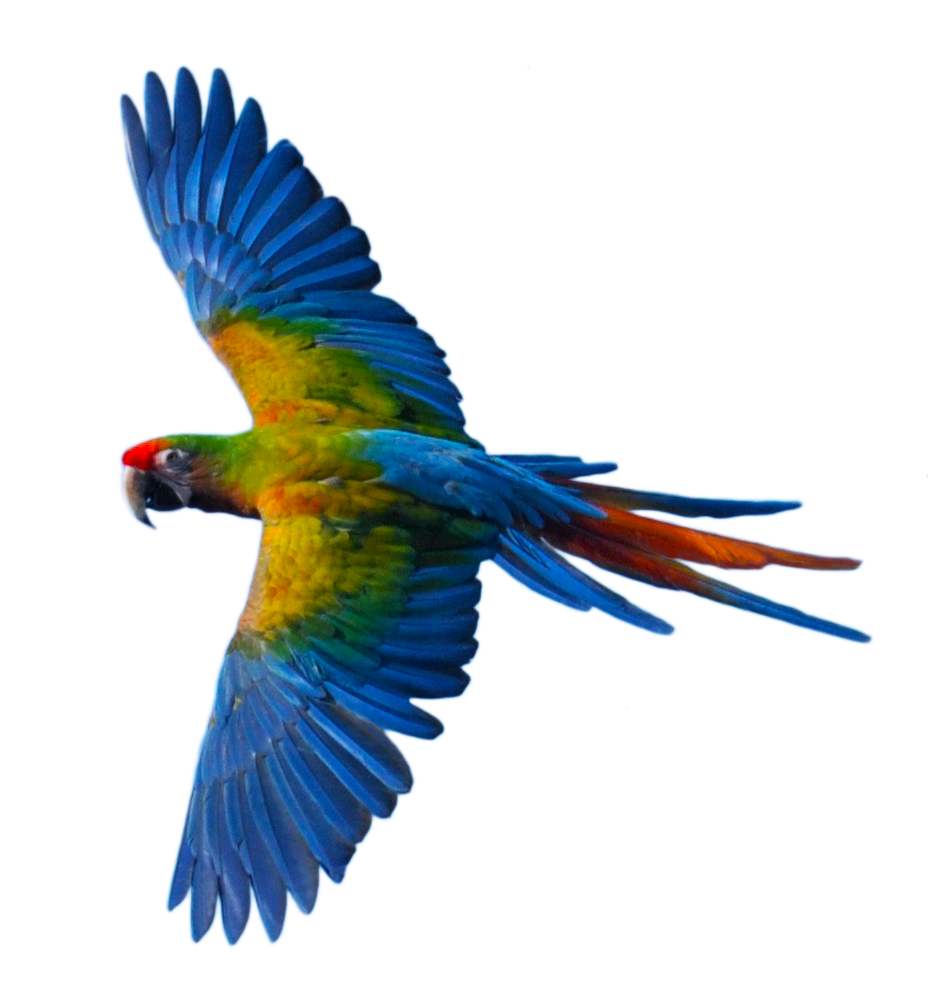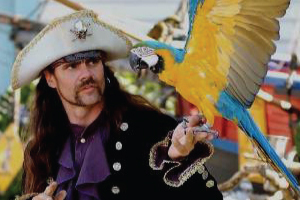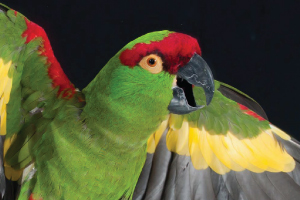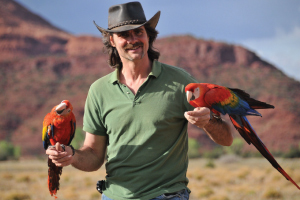
Empowerment vs. Coercion
Written by Chris Biro, Copyright 2-13-2009
A freeflight list member wrote “I am reading all these messages about the benefit of empowering parrots. This sounds like something I need for my birds as food training is starting to bore them. Can someone please explain what empowering is and simple training examples? Thanks.”
I think the concept of empowering is about helping the bird figure out it can control elements of its environment, namely us. The trick to good bird training is helping them see that through their actions they can cause us to do things they want us to do. Training with positive reinforcement sends exactly that message. The trouble is in how to communicate this concept to the bird. Since we do not speak their language it is all about communication through body language. We use body language in the sense that we communicate through motions, sounds, inflections and timing – by sounds I am talking about sounds that do not already have dictionary definitions associated with them (like words do) 😀 . We use a bridging signal (the click) to mark the moment in time the bird did that special something that triggered you to give the bird something it wanted (the seed or nut). In this way the bird can learn to recognize what behavior it does that influences you.
For the bird to feel empowered, we have to do our part in the above process. The bird cannot influence us if we do not play the game in a consistent manner. So by empowering, we make it possible for the bird to feel it has some control by actually volunteering some responsibility to comply with its requests. These requests are not just about it choosing to do what we ask, but also allowing it the choice not to do some things we ask. WIthout the freedom to choose not to comply, there is in fact no actual choice involved.
Empowering is creating a training environment where the bird truly does have choices that do influence your behavior in ways the bird wants.
When we use a clicker we are using a unique sound precisely timed to make the communication process more clear and more accurate. If you don’t think the clicker makes that much difference, I would say try training a chicken to peck a spot without the clicker and this will become more clear.
A freeflight list member wrote “Everyone seems to keep thinking that empowering the bird is actually giving them full control. I don’t think that is what it is. I think it is allowing them to BELIEVE they have full control.”
I agree, empowering does not mean they have full control of their lives. Empowering grants them certain control of various aspects of their lives and the ability to recognize what they have control over and what they do not. The later part is often hard to keep clear both for the trainer and the bird.
“It doesn’t necessarily mean they do but they believe they do.”
I think this is a dangerous slippery slope you are on. It is not easy to keep up this appearance unless it is real. There is a dishonest component to this way of thinking that I believe the birds will quickly see through.
When I am using a clicker to work with a bird, the bird does not just think it has control to get me to click and treat. It truly does. But only because I have agreed to this rule and faithfully honor it. The control the bird feels must be real. It is made real by my level of commitment to keeping it real through my actions. This is not about faking the bird out often enough that it stays willing to participate. It is about setting clear rules and boundaries so both of us are on the same page.
Those rules are defined so that I get what I want and the bird gets what it wants. It just so happens I want the bird to be happy and mentally healthy so I expand the bird’s choices in all areas I think will let us harmoniously live together. In some situations that does not grant the bird very many choices. In other situations the bird has lots of choices. And both of us understand these rules. That is certainly not granting total control. But this seems to be a workable solution for my birds in my situation.
A freeflight member writes “I believe that most of us that have flighted birds indoors do a lot of manipulation, or just quietly lure them back into their cages before things get out of hand.”
Manipulation I think is another word for control. Control is part of everyday life and is absolutely ok in many instances. It is not ok when it becomes coercive. No one complains when they are controlled by positive reinforcement methods. It is when the control takes on coercive components that we dislike it. Even if it involves being set up to face situations that involve removing something we wish to avoid (negative reinforcement).
Control is not bad. Coercive control is bad. Knowing what the difference is is good <grin>.
“What is coercive manipulation and why is it bad?”
Great question. Coercive manipulation or coercive control is the use of aversives or the threat of aversives to get an animal to do as we would like. It also includes our practice of rewarding them by allowing them to escape our use of aversives or our threat of aversives. So if you look carefully at this definition you would see this includes three of the four quadrants of operant conditioning.
Positive Punishment, Negative Punishment and Negative Reinforcement. The first two are pretty obviously coercive. The Negative Reinforcement though can confuse people into thinking it is not coercive just because it contains the concept of reinforcement in the name. But lets not forget that to set the animal up to be able to remove an undesirable factor first requires you to provide that negative factor and at such a rate that the animal truly desires to be free of it. That is setting up a coercive situation.
I see Coercion as the exact opposite of Empowerment. As such it is not possible to empower through coercive methods.
So why is this bad? Aside from ethical issues, from a practical position, the negative side effects are often worse than the original problem. There are many reasons we turn to use of aversives and coercion. Primarily because it often works in the short term and thus is reinforcing for us. Thus we tend to use it again (as is what happens to any behavior that is reinforced). But those two words “short term” that create the problem. Coercive methods may bring about short term results but the long term effects accumulate to create serious problems.
One of the problems is that successful use of punishment encourages additional use of punishment. Use of aversives can quickly become the norm rather than the exception.
Another serious side effect is the secondary punisher effect. When a neutral stimulus becomes associated with an aversive the neutral stimulus also then takes on the punishing qualities of the original aversive stimulus. This pairing process is how the person who applies punishment to control behavior also becomes viewed as an aversive stimulus. If the bird connects you with the punishment, then you will become an aversive. If this intelligent animal comes to see you as the withholder of all the fun things it wants, it will come to see you as an aversive. If it feels coerced by you to perform against its will then you can become an aversive.
Just like there are primary and secondary reinforcers, there are also primary and secondary punishers. The difference between primary (unconditioned) and secondary (conditioned) is the primary is inherently punishing while the secondary gains its punitive qualities through association with another punisher. Often the difference is described as the secondary is learned. This is generally true but not entirely accurate since there are learned components to many primary punishers (as well as primary reinforcers).
I personally see the above two problems with coercion as the two most serious and most likely to be encountered by animal trainers. There are many others undesirable potential side effects such as learned helplessness, depression, displaced aggression, escape, avoidance, loss of creativity, loss of motivation, phobias, compulsive behavior, etc.
I suspect that many of the behavioral disorders we see in parrots are directly related to the amount of coercion in the animal’s life. Most live in coercive enclosures that remove by force nearly all choice and action from their lives. We do not need to add to this by intentionally using coercive methods when positive alternatives exist. With that said, we should also not swing the pendulum in the opposite direction and pretend aversives are not part of life or tools in our training tool box. We need to strive for using positive methods whenever possible and always be aware that as our skill with positive methods increases, so will our ability to find positive solutions increase. Setting boundaries is a critically important element to living with parrots. The ability to do so with positive reinforcement and minimal coercion is both an art and a goal.
A freeflight member wrote “I’m confused at how we are using the word manipulation and missing the fact that if a bird chooses to do something, regardless of if we set it up that way, it is somehow implying they don’t have choice or that it is demeaning. It is entirely how life works for all of us. If the consequence for doing a behavior is desired, I choose that. If a bird learns that doing xxx behavior gives it something more worthwhile than yyy behavior what was manipulated? Don’t lose sight of the fact that it is only the one doing the behavior that decides if a consequence is reinforcing.”
I think the problem here is that the word “manipulation” and the word “control” have gained negative connotations due to how they are often misused. We manipulate our food as we eat it. We control our cars as we drive. It is only when that control or manipulation is done through a coercive method that there is a negative component to either.
Control by itself is normal and neutral. The method of control is what makes all the difference. A bird may have been set up to choose between two bad options of avoiding two things it does not like, and may choose the lesser of the evils. The fact that it did make a choice, then did the behavior and that it was “reinforced” by its own perception does not mean the control/manipulation was good. There was still a coercive component.
The one doing the behavior does define if a stimulus is reinforcing or not by its future behavior but I as the trainer also can detect coercive methods and avoid them when possible. Setting the animal up to face choices to avoid something only so that I can remove it, thus I am using reinforcement, is still a coercive approach. That distinction needs to be understood. Positive reinforcement is always preferred over negative reinforcement or either punishment (positive or negative) because it is the only quadrant that does not contain a coercive element.
A freeflight list member wrote “I believe a bird can get empowered without me in the formula, as I know a child can be empowered if we let her be creative.”
There is a difference in meaning between the two words, POWER and EMPOWER. As you can see both have a common root of power. But the later, empower, implies the assistance of an outsider rather than inherent power. I cannot empower a wild bird because it has all its natural power in its unrestricted freedom and full compliment of natural behaviors and skills. But the pet bird does not have that same set of conditions. In fact it has very few natural powers available to it since I control its cage time, food, toys, and every other aspect I wish to control due to my position of superior physical strength. On the other hand though, I can choose to grant it back some of that power through my voluntarily not using all my physical constraint options and allow the bird to actually have some control over various elements of its life. That not only grants the bird some actual control but it also eases the stresses and negative fall out associated with coercive control, especially from learned helplessness.
“So, are you telling that you just can empower a bird IF you are involved?! I mean, empowering it’s not only having influence on your actions BUT have influence on the environment and you are just a part of that environment.”
There is more to it than just me being involved. It comes down to how I am involved. The concept of contingency is important.
“A very good example is foraging. Foraging does empower a bird and you probably aren’t there!”
Foraging is an example of empowerment but maybe not a good example for this discussion. The animal does certain things that have a contingent relationship to finding certain food items. When our birds are loose outdoors in Moab they use us as foraging sources of goodies. They choose to come interact with us, knowing they can cause us to give them peanuts. They also first thing in the morning go forage on wild juniper berries. But this only works because I have enabled them to do this by giving them the freedom to go do these things. I could just as easily keep them caged or on a tight mental leash and not allow them to go do these things. So this is an example of foraging as empowerment but on a much different scale then most people will offer their birds. This example may actually confuse people about what empowerment is because our birds do have the power to feed on juniper berries but this only happens because have given them freedom and skills needed to be out doing so.
“If you left some hidden items in the cage and your bird is able to find them, then he will perceive that he can get something from the environment on his own…. try to rise the difficulty of finding those items and he will try harder… and will feel even more empowered than before. Don’t you agree?”
Yes I do agree but I don’t think this really fits into what people mean when they talk about empowering in training discussions.
“I found this can be a good technique to “no hands” birds. Or with birds that are afraid of you. You can even build the confidence of the bird without being present… even so, the bird will be empowered, thinking he can rule his environment.”
It is not really about ruling the bird’s environment, because the bird does not rule it. I think it should not feel it does rule when in fact it does not. That to me is asking for problems that do not need to exist. I think it needs to understand it has some things it can influence through its actions and others it cannot. This is simply how life works for all of us. It also needs to recognize the contingency element, the cause and effect element.
As per my understanding of what “spoiled means – getting things without respect to any actions. A spoiled child is not empowered by thinking it can do whatever it wants or that it rules everyone. Empowerment involves an element of having power. Power is the ability to make things happen. The spoiled child does not actually make anything happen. It gets what it wants without a contingent element connecting its behavior to what it gets. It acts with out concern for the contingent consequences.
Empowerment is helping the bird have actual power and then helping it recognize what power it has. Birds who live in a cage do not really have much power unless we give them some through our voluntary effort. It is kind of like the cursor on your computer. You do have control of it but only in as much as the mouse enables you to move it around. If the mouse fails to comply, you lose your power over the cursor. You as the trainer are the mouse that enables the parrot to move the cursor. As such this becomes a team effort. You become codependents. Empowering implies a reliance on you to fulfill certain commitments and duties so that the bird can come to feel it has real power.
Empowerment also is commonly used to indicate someone who offers support to another person. This is true with our birds too. But since we do keep them in cages, and control most aspects of their lives, it takes on a slightly more active role for us than simply offering support. It requires us to give back a certain amount of the freedom we are able to keep from them. As the controllers of their freedom, the more freedom we are able return, the more we are empowering them.
A freeflight list member wrote “Could have sworn that is what I said when I explained…to learn from the consequences of those choices. Past consequences form future antecedents. Consequences come in all forms. Remember, its what behavior is all about. I learn that if I do xxx I don’t like the consequence so given the same situation again, I will make a different choice.”
Not exactly, but close. My point was to distinguish good decision making from just making decisions. There is a skill to this that can be learned with practice and guidance. Learning to make choices based on consequences starts very early in life. But learning to consistently make good choices is a little different because in this case the “good” is defined by us, the handler.
Therefore we have to be consistent in our rules, how we apply them and our methods. This takes teamwork between us and the bird if it is going to be successful in the sense of empowering the bird. No matter how we look at this it always involves more than just offering choices for empowerment to work. It takes an active role on our part to help make those choices effective and in the animal’s and our best interests. So actually we both must learn to help make good choices, not just choices.
A freeflight member wrote “I watched Biro’s birds at liberty in Moab last October and they are truly empowered. I cannot see how it apples to our captive birds whom we are constantly manipulating.”
Yes when our at liberty birds are loose outdoors they are empowered in ways most bird owners cannot even imagine. In their indoor cages, they are still the same wonderful birds even though they have far fewer options while caged. So in some ways they are living with the two extremes – near total control and nearly no control. It is one of the reasons we love to go to Moab and I believe also why they appear so happy while there. I cannot build large enough cages and have come to recognize this as part of the lifestyle changes that come with keeping flighted parrots. It is much more like keeping horses in that we need the right location and set up to do it “right”.
Empowerment by itself does not equate to high quality of life. It is only a part of developing quality of life. Empowering a bird in a cage to have control of various bits of its caged life can help but may still leave the owner feeling their bird has insufficient quality of life. My point here is to suggest people not confuse the two issues.
This brings up yet another aspect of empowerment. It is not enough to just be faced with a choice. It is not enough to also have the option to choose not to take the handler’s preferred choice. It is not enough to have several elements that the bird has control over in its life. There is also the necessary component of developing the ability to make effective choices. There is power in being able to think through an issue and make a good choice. To teach them this ability though involves their meeting both with results they like and results they might wish to avoid. In other words, they need not only to experience the spoils of doing things you want but also the effects of facing boundaries. Boundaries are terribly important and actually help empower the bird. But setting boundaries and maintaining them can be a really tricky line to establish without being coercive. It is easy to go past boundary setting into coercive manipulation.
Being able to make effective choices can help the bird learn to coexist with us in our world. Their natural tendencies were designed for a completely different environment. But that does not mean they cannot learn to adapt to the environment we keep them. Flight is certainly one way we help them fit into both worlds. But the key for flight to work in this respect is effective decision making. Effective decision making is equally important for non flighted birds.
Teaching what the boundaries are and how to make good choices to effectively work within those boundaries expands the level of freedom you can give the bird. This then is empowering since it grants them greater power over their lives.
Parrots: more than pets, friends for life.Chris Biro
Resources and More
The Pirate's Parrot Show
An educationally based pirate-themed parrot show performing at state and county fairs since 1991. The Pirate’s Parrot Show is a Fun, Educational, and Interactive experience for all ages and cultures.
Bird Recovery International
One in every eight bird species in the world today is in danger of extinction and these numbers are increasing! Find out how this non-profit organization started by Chris Biro can help save and protect parrots and other birds.
Podcasts with Chris Biro
An Alternate Perspective – Enjoy these audio Podcasts of Chris with guests discussing the nature of training flighted birds. The discussions are intended to be loosely structured around a general topic.
Email Us
chris@libertywings.com
Call Us
(206) 618-2610
Contact Us
By Using the Contact Form




Article Comments